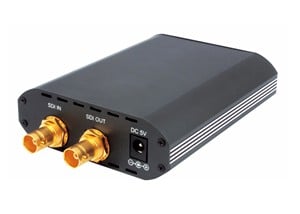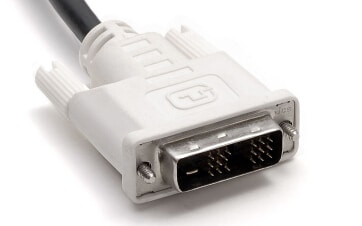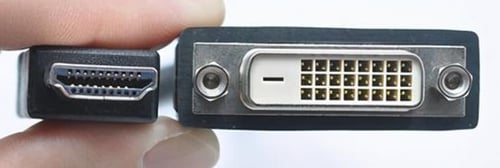Network Cabling
What is the difference between SDI, HDMI, DVI, ASI?
Update on April 18, 2023
Looking closer at HDTVs and digital cameras, we may find many different interface types, such as HDMI, DVI, ASI, and SDI. However, you may not understand their differences or know how to choose. So in this article, we will compare these terms in detail and discuss their differences.
Now let’s go on.
Table of Contents
What is ASI?
Asynchronous Serial Interface (short for ASI) is a serial transmission, just a coaxial cable transmission, a simple connection long transmission distance. According to the respective advantages and disadvantages of SPI and ASI, the SPI and ASI interfaces are often interchanged when transmitting signals.
ASI transport stream may have different data rates (data stream size), but the transfer rate is constant, 270Mbps so ASI can send and receive different rates of MPEG2 data. ASI transmission system for the hierarchical structure. The highest layer, layer 2 uses the MPEG2 standard ISO / IEC 13818-1 (SYSTEM), and layers 0 and layer 1 are FC fiber channels based on the 1SO / IEC CD 14165-1. FC supports a variety of physical transmission media, such as coaxial cable transmission.
First, the 8-bit codeword of the MPEG2 transport packet is converted into a 10-bit codeword. Then when a new word is requested and the data source is not ready, a K28.5 sync should be inserted in Word to achieve a fixed 270Mbps ASI transfer rate. The resulting serial bit stream is routed to the coaxial cable connector through the buffer/driver circuit and coupling network.
When receiving data through the coaxial cable, when receiving and receiving data, it must first go through the connector and the coupling network, coupled to the recovered clock and data circuits, and then perform the serial/parallel conversion. The K28.5 sync word must be searched first to recover the byte synchronization.
Once the sync word has been explored, the boundary of the subsequently received data is demarcated so that the correct byte order of the decoder output byte is established. Finally, a 10/8 bit transform is performed to recover Packet synchronization MPEG2 TS stream data. However, the K28.5 sync word is invalid data, so it must be deleted when decoding.
What is SDI?

SDI is an abbreviation for Serial Digital Interface, which is a serial digital interface. The serial interface is the data word of each bit and the corresponding data transmitted through a single channel interface. Due to the high data rate of serial digital signals, they must be processed before being transmitted. The NRZI is used instead of the early block codes, based on the SMPTE-259M and EBU-Tech-3267, which include digital composite and digital component signals, including digital audio.
SDI is divided into standard definition SD-SDI and HD-SDI interface standards. The primary connection between high-definition digital television production equipment is the serial digital component interface HD-SDI.
- SD-SDI complies with the SMPTE259-C standard, and embedded audio complies with the SMPTE272M standard. The code rate is 270Mbps.
- HD-SDI complies with the SMPTE-292M standard, and embedded audio complies with the SMPTE299M standard. The code rate is 1485Mbps.
We know analog signals (also called continuous signals) are sampled and quantized into signals not constant in time and amplitude (also called discrete signals). Such signals are not yet digital and must be converted into digital symbols (Such as natural binary code). The baseband signal compression does not encode this code stream, has a more significant code rate, and takes up a more extensive transmission bandwidth.
This code stream transmission interface is the serial digital SDI interface. It belongs to the channel code stream, so the SDI transmits a digital video signal that is not compressed after quantizing the sample (you can also embed the audio).
-
 3G-SDI BiDi SFP Video 1550nm-TX/1310nm-RX 40km Transceiver for SD/HD/3G-SDIUS$ 95.00 (Excl. VAT)
3G-SDI BiDi SFP Video 1550nm-TX/1310nm-RX 40km Transceiver for SD/HD/3G-SDIUS$ 95.00 (Excl. VAT) -
 3G-SDI BiDi SFP Video 1310nm-TX/1550nm-RX 40km Transceiver for SD/HD/3G-SDIUS$ 95.00 (Excl. VAT)
3G-SDI BiDi SFP Video 1310nm-TX/1550nm-RX 40km Transceiver for SD/HD/3G-SDIUS$ 95.00 (Excl. VAT) -
 3G-SDI BiDi SFP Video 1550nm-TX/1310nm-RX 10km Transceiver for SD/HD/3G-SDIUS$ 79.00 (Excl. VAT)
3G-SDI BiDi SFP Video 1550nm-TX/1310nm-RX 10km Transceiver for SD/HD/3G-SDIUS$ 79.00 (Excl. VAT) -
 3G-SDI BiDi SFP Video 1310nm-TX/1550nm-RX 10km Transceiver for SD/HD/3G-SDIUS$ 79.00 (Excl. VAT)
3G-SDI BiDi SFP Video 1310nm-TX/1550nm-RX 10km Transceiver for SD/HD/3G-SDIUS$ 79.00 (Excl. VAT) -
 12G-SDI CWDM SFP+ Video 40km Transceiver for SD/HD/3G/6G/12G-SDIUS$ 299.00 (Excl. VAT)
12G-SDI CWDM SFP+ Video 40km Transceiver for SD/HD/3G/6G/12G-SDIUS$ 299.00 (Excl. VAT)
What is HDMI?
HDMI is a high-definition multimedia interface that supports HDCP, mainly for consumer electronics. HDMI is the first digital interface that supports all digital high definition, multi-channel audio and intelligent format and control command data transmitted over a single cable without compression.

Silicon Image American Imaging Inc developed the HDMI interface. It was jointly developed by eight renowned consumer electronics manufacturers, including Sony, Hitachi, Panasonic, Philips, Thomson, and Toshiba. The first HDMI interface specification HDMI1.0 released in December 2002, and the current highest version was released in June this year, the HDMI1.3 specification.
As the HDMI interface can provide up to 5Gbps data transmission bandwidth, you can send uncompressed audio signals and high-resolution video signals without signal transmission before the digital/analog or A / D conversion to ensure the highest quality audio and video signal transmission.
HDCP is an acronym for High-bandwidth Digital Content Protection. High-bandwidth Digital Content Protection (HDCP) is an encryption technology designed for the high-definition video to prevent video data from being transferred between digital video output (DVI or HDMI) on a computer and a monitor Between was copied.
HDCP technology by Hollywood and the giant semiconductor Intel co-launched can be used in video cards, DVD players, other transmission ends, monitors, and TV sets between the receiving end of the projector. It is an essential anti-piracy technology for high-definition movies and television programs. Displays not supporting the HDCP protocol cannot play a copyrighted HD program.
HDMI is pin-compatible with DVI, except it uses a different package. The HDMI port is fully compatible with the DVI port at the output. The cable length of the DVI port can not exceed 8 meters. Otherwise, the signal quality will be degraded. However, the HDMI interface cable can transmit as far as 15 meters and supports a 5Gbps data rate. That is enough to handle one 1080p video and one 8-channel audio signal (less demand for one 1080p video and one 8-channel audio signal) At 4GB / s).
The HDMI connector connects a single cable to a DVD player, receiver, and PRR. In addition, HDMI supports EDID and DDC2B, so HDMI-enabled devices have “plug-and-play” features. The signal source and display devices automatically “negotiate” to select the most appropriate video/audio format. Simply put, the difference between the definition of HMDI and DVI and some friends on HMDI some cognitive errors to correct.
Therefore, when purchasing a monitor or a video card, it is not necessary to have an HDMI interface. In connection with an ordinary desktop computer and a liquid crystal display, I think a DVI cable connection is the most simple and worry-free unless your monitor or video card is also connected to the PS3, LCD TV such equipment needs.
What is DVI?

DVI, digital video interface. With the development of display technology, especially the wide application of digital LCD, DLP, and PDP products, the traditional VGA analog signals are unsuitable for development needs. In many applications, they are replaced by DVI digital signals.
In the analog display mode, the R.G.B signal in the graphics through the D / A converter into an analog signal; after transmission into the display, the processed drive R.G.B gun is displayed on the screen, and the entire process is simulated.
Unlike DVI digital display, analog RGB signals arrive at the display device (LCD or DLP, PDP, etc.) through A / D processing, converted to digital signals, followed by the digital signal to control the LCD panel to transmit or reflect light or DMD chip reflected light Or reflected by the plasma to achieve the display effect. In this process, there is a conversion process from digital to analog to digital with significant signal loss and problems such as smearing, blur, ghosting, and the like.
Computer graphics with digital interfaces have become quite common in today’s devices. Even laptops are equipped with DVI interfaces, and most display graphics processors have even digital signal interfaces on them. The display device is also the more equipment with a digital signal interface, so the digital → digital application has matured. DVI signal is a new media, and its application is increasing widely.
SDI vs HDMI

- Different principle: HDMI supports uncompressed 8-channel digital audio transmission, any compressed audio stream such as Dolby Digital or DTS, and the SACD’s 8-channel 1-1 bit DSD signal. SDI is based on the SMPTE (Society of Motion Picture and Television Engineers) serial link standard for high-definition real-time transmission of uncompressed digital video over 75-ohm coaxial cable. The original image over SDI will not be distorted.
- Different distances: SDI cables can reach 120~400 meters, while HDMI cables have a maximum length of 40 meters. This makes SDI more suitable for digital video broadcasting applications. However, the length of HDMI can be increased using an amplifier or repeater.
- Different Connectors: HDMI connectors are similar to USB in that they can be easily unplugged intentionally or left unplugged. They do not have a tight lock, which makes them very easy to remove. In contrast, SDI has sturdy connectors held in place by BNC cables.
DVI vs HDMI

- Different maximum resolution: DVI single-link interface supports a maximum resolution of 1920*1200@60hz; the DVI dual-link interface supports a maximum resolution of 2160*1600@60hz or 3840*2160@30hz. HDMI1.4 supports a maximum resolution of 3840*2160@30hz; HDMI2.0 supports a maximum resolution of 3840*2160@60hz; HDMI2.1 supports a maximum resolution of 7680*4320@60hz.
- Different transmission content: DVI interfaces usually only transmit video images, while HDMI interfaces can transmit both video and audio. HDMI can be regarded as an enhancement and extension of the DVI interface. Therefore, DVI is mainly used for computer monitors, while HDMI is mostly for HDTVs.
- Different data rate: DVI interface usually provides 5Gbps/single link or 10Gbps/dual link. HDMI 1.4 supports 10Gbps, HDMI 2.0 supports 18Gbps, and HDMI 2.1 support 48Gbps.
Conclusion
DVI interface can only transmit video data and can not transmit audio signals. This interface can transmit HDCP signals if the hardware meets the relevant specifications.
SDI is a professional video transmission interface generally used in broadcast video equipment. SDI and HDMI both support uncompressed digital video transmission, but the HDMI interface uses the 19-line transmission, SDI with the ordinary 75-ohm coaxial line can. HDMI can only transmit the longest 40 meters, and SDI can reach 120-400 meters.
HDMI and SDI applications in different areas will be no conflict, HD-SDI can only do 1080I, and now the latest version is 12G-SDI, which supports 2160p60.
Reference:
Read more:
- SDI, HD-SDI, 3G-SDI, 6G-SDI, 12G-SDI and 24G-SDI: The Definitive Guide
- Optcore SDI video transceiver solution
- How to test the SDI signal?
- Optcore Shipped 10,000 sets 3G-SDI video transceiver







